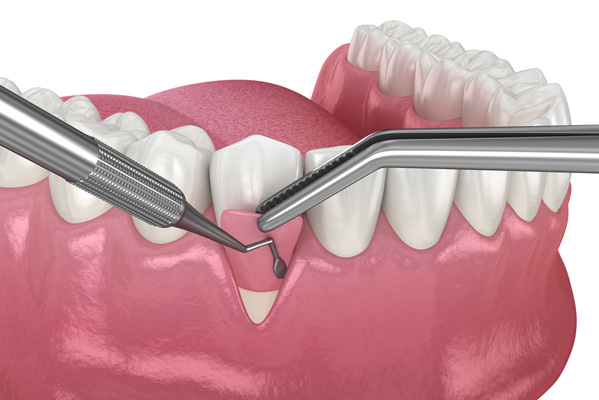Pocket Reduction SurgeryThe Woodlands, TX
Pocket reduction surgery, also known as osseous surgery, helps keep the mouth and body healthy by removing debris from the pockets that form as a result of periodontal disease. Healthy gums should have pockets (or openings under the gum line) less than 2- to 3-millimeters in depth. Gum disease can deepen these pockets. Pocket reduction surgery can help.
Pocket reduction surgery is available at Montgomery County Periodontal Associates in The Woodlands and the surrounding area. Take control of your oral health. Call us today at 281-404-7548 to schedule an appointment or learn more about our services.
Understanding Pocket Reduction Surgery
According to Healthline, once the gaps between the teeth and gums become deeper than 5mm, they become extremely difficult to clean — "even with a professional cleaning by a hygienist." This often occurs due to gum disease, also known as periodontal disease, which is caused by excess plaque. If left untreated, periodontal disease can cause the pockets to continue to deepen until tooth extraction is necessary.
Pocket reduction surgery cleanses the deep pockets formed by gum disease, pulls back the gums, and removes any tartar buildup. The tooth is also smoothed out to minimize any hiding spots for bacteria. This surgery is usually performed under local anesthesia as an outpatient procedure.
Check out what others are saying about our Pocket Reduction Surgery services on Yelp: Pocket Reduction Surgery The Woodlands
Reasons for Pocket Reduction Surgery
As the name suggests, the primary goal of pocket reduction surgery is to reduce pockets formed by gum disease or eliminate them altogether. It is estimated that up to 90% of all people worldwide have gingivitis, a mild form of periodontal disease that has yet to spread to the jawbone or connective tissue.
If left untreated, gingivitis can progress to periodontitis, which can cause permanent damage to the bone supporting the teeth. Ultimately, this may lead to tooth loss or even affect one's systemic health. Pocket reduction surgery aims to minimize the chances of such disastrous health occurrences when less invasive methods, such as root planing and scaling, are not enough. It also typically has a high success rate.
What Happens During Pocket Reduction Surgery
Patients will undergo a thorough dental cleaning before their pocket reduction surgery. Then, Dr. Mason will numb the infected area with a local anesthetic before making a small incision around the teeth. Once he can reach the roots and bones, he will clean the area through scaling. The bones around the teeth will be cut into shape via hand tools and a drill, with Dr. Mason smoothing down any areas that are damaged or irregularly shaped.
A bone graft may also be performed if necessary (typically only when the bone is severely infected and must be rebuilt). Once all the infected tissue is removed, Dr. Mason will pull the gum back over the bone and suture it together. It will be bandaged as part of the healing process.
Recovering from Pocket Reduction Surgery
For most people, it only takes a few days to return to everyday activities after pocket reduction surgery. However, for best results, patients should refrain from smoking or drinking alcohol for at least a week after surgery. Additionally, patients who wear dentures may have to stop wearing them for a short period while the mouth heals.
Patients will be required to return to our office within seven to 10 days after the surgery so we can check on healing and remove any stitches as necessary, and most people feel fully recovered in approximately two to four weeks. Some swelling and bleeding after surgery are not uncommon, and we will provide each patient with the proper aftercare instructions to keep the mouth clean. We may also prescribe pain medication to relieve discomfort.
Frequently Asked Questions
Is pocket reduction surgery right for me?
Pocket reduction surgery may benefit anyone with advanced periodontal disease that needs to be treated right away. However, some patients may require more precautions than others. This includes patients who are pregnant or have allergies to certain medications. In order to allow us to provide you with the best and safest care available, be sure to let us know if you have any preexisting conditions or are taking any medications or supplements.
How should I prepare for pocket reduction surgery?
The first thing you should do to prepare for pocket reduction surgery is to come to our office for a one-on-one consultation. We can perform a thorough physical examination and determine whether the procedure is right for you. On the day of your procedure, make sure to wear comfortable clothes that you do not mind getting dirty. Though we will cover your chest with a smock during surgery, you may still get some splatters of fluid on your clothing during the procedure. Make sure that you have someone who will drive you home from surgery, as anesthesia will leave you unable to transport yourself.
What are the potential risks associated with pocket reduction surgery?
While pocket reduction surgery is a generally safe procedure when performed by a trained specialist, every procedure comes with its own unique set of risks. Pocket reduction surgery may make one more likely to develop root-based cavities in the treated teeth, oral infections, receded gumlines around the treated teeth, or sensitive teeth. Still, patients should remember that Dr. Mason will only recommend the procedure if he determines that the benefits outweigh the risks.
What can I do to help speed up my recovery from pocket reduction surgery?
Keeping the head elevated above the heart can reduce swelling and help expedite feelings of recovery. Patients may also want to bite down on a piece of gauze to apply pressure when bleeding starts. It is best to stick to a soft food diet after surgery, avoiding any hard or sticky foods or carbonated beverages. Stay hydrated with plenty of water, and refrain from using a straw until the mouth has fully healed.
Will I need to get pocket reduction surgery more than once?
The answer varies on a case-by-case basis. Some patients may need to have multiple pocket reduction surgeries if their gum disease has advanced to more than one area of the mouth or if they require dental implants.
Contact Us
Montgomery County Periodontal Associates is located at 1001 Medical Plaza Dr Ste 110 The Woodlands, TX 77380.





